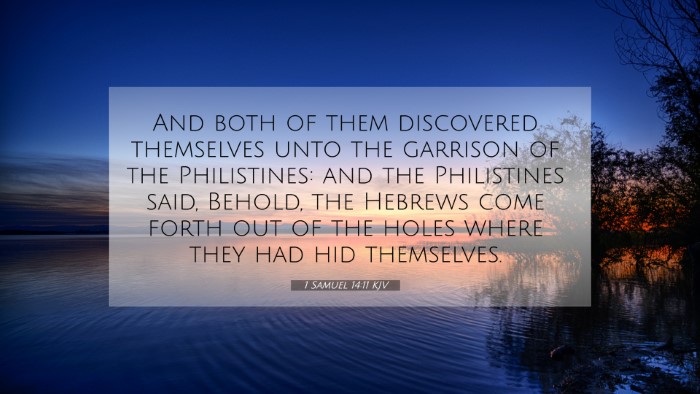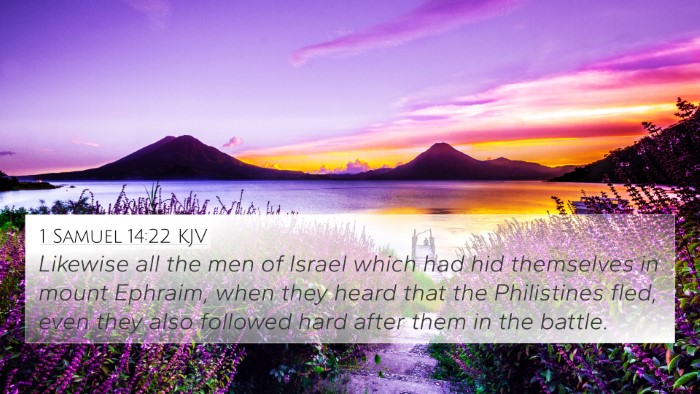Understanding 1 Samuel 14:11
Bible Verse: 1 Samuel 14:11
This verse reads: "And both of them discovered themselves unto the garrison of the Philistines: and the Philistines said, Behold, the Hebrews come forth out of the holes where they had hid themselves."
Overview and Key Themes
The passage focuses on Jonathan and his armor-bearer as they reveal themselves to the Philistine garrison. This action is significant, demonstrating the faith and boldness of God's chosen leaders in the face of overwhelming odds. Here, we explore various interpretations and meanings derived from prominent public domain commentaries.
Commentary Insights
Matthew Henry’s Commentary
Matthew Henry emphasizes the courage of Jonathan. He points out that Jonathan's decision to confront the enemy was rooted in faith, illustrating the idea that faith often leads to bold actions. He highlights that such acts of faith can often provoke divine intervention and that God can deliver in unexpected ways, just as He did when Jonathan led his charge.
Albert Barnes’ Notes
Albert Barnes notes that this event marks a turning point in Israel's conflict with the Philistines. He contextualizes the fear that had gripped the Israelites and contrasts it with the boldness shown by Jonathan. According to Barnes, the Philistines' mocking words reveal their arrogance, which ultimately sets the stage for God's deliverance through Jonathan’s fearless approach.
Adam Clarke’s Commentary
Adam Clarke suggests that the act of revealing themselves was a strategic move meant to gain the upper hand over the Philistines. Clarke discusses how this act can symbolize spiritual warfare, where transparency and honesty against evil may lead to victory. He aligns Jonathan's actions with the greater theme of God's deliverance in the scriptures.
Biblical Cross-References
1 Samuel 14:11 can be linked to several other Bible verses that enrich its understanding:
- 1 Samuel 13:19-22 - This passage illustrates the dire situation Israel faced and sets the background for the boldness of Jonathan.
- 1 Samuel 14:6 - Jonathan's proclamation of faith in God demonstrates his reliance on divine support, enhancing the context of his actions.
- Joshua 1:9 - The theme of courage is echoed throughout Scripture, reminding believers to be strong and courageous in God’s service.
- Hebrews 11:32-34 - This New Testament passage recalls the heroes of faith who, like Jonathan, acted through faith and led to victories.
- Psalm 56:11 - This verse affirms trust in God, correlating with Jonathan's faith as he faced the Philistines.
- Isaiah 41:10 - God's exhortation against fear directly ties into the bravery shown by Jonathan in confronting their foes.
- Romans 8:31 - The assurance that if God is for us, who can be against us resonates with the acts of courage displayed in 1 Samuel 14.
Application and Reflection
1 Samuel 14:11 teaches valuable lessons about faith and courage in the face of adversity. The text encourages believers to take bold steps when prompted by faith, trusting that God is with them. This theme is not only prevalent in the Old Testament but also finds connections in the New Testament, where faith is a cornerstone of the believer's journey.
Conclusion
In connecting 1 Samuel 14:11 with other scriptures, we find a rich tapestry of biblical truths that encourage courageous faith. Using tools for Bible cross-referencing can enhance the understanding of such themes, allowing for deeper explorations into how these verses interrelate. The practice of cross-referencing not only aids in interpretation but also reveals the consistency and unity of God's message throughout the Bible.
Further Studies on Cross-Referencing
For those looking to dive deeper into the world of Bible cross-referencing, several tools and methodologies can aid in uncovering connections:
- Bible Concordance - A helpful resource for locating verses and their occurrences throughout the Bible.
- Bible Cross-Reference Guide - Offers insights into related verses, enhancing the understanding of themes.
- Cross-Reference Bible Study - A method that encourages group discussions based on cross-references.
- How to Use Bible Cross-References - Learning to identify and utilize cross-references can enrich personal study and sermon preparations.
- Bible Chain References - Linking multiple verses on a single theme can deepen understanding and application.





